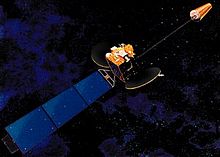MSAS
Multi-functional Satellite Augmentation System ( MSAS ) is a Satellite Based Augmentation System and the Japanese counterpart to the EGNOS system in Europe . The MTSAT satellites combine meteorological and communication services. They orbit the earth in a geostationary orbit over the Eastern Pacific . MSAS stands for: M TSAT S pace-based A ugmentation S : ystem, MTSAT for M ultifunctional T ransport Sa tellite S ystem.
The satellites transmit correction and integrity data for independent satellite navigation systems (currently GPS ) for the area of Japan . The system is operated by the Meteorological Authority and the Japanese Ministry of Infrastructure and Transport .
On August 1, 1999, the launch of the first MTSAT-1 satellite failed. It missed its pre-calculated orbit .
The replacement satellite MTSAT-1R was launched on February 26, 2005 with an H-IIA from Tanegashima into geostationary orbit near 140 ° East. MTSAT-1 and MTSAT-1R were built by Space Systems / Loral based on standard Loral satellite buses . MTSAT-1R is a Japanese communications satellite that is also used for flight monitoring and guidance. Its launch mass was 2900 kg, 1650 kg of which was fuel. The satellite delivers an electrical output of approx. 3 kW. Communication takes place with the ground station in the Ku and Ka bands . It supports the communication standard AMSS ( Aeronautical Mobile Satellite Service ). Aircraft can use it to send data to the ground station in the L-band and also transmit radio communications via it.
MTSAT-2 (Himawari-7) was successfully launched on February 18, 2006 with an H-IIA rocket. It is positioned in geostationary orbit at 145 degrees East. MTSAT-2 was developed and built by Mitsubishi Electric with support from Boeing Satellite Systems and Alcatel Space. He was replaced by Himawari 8 on July 7, 2015 .
MSAS has been operational since September 27, 2007.
Web links
- MTSAT Technical Information
- JMA website on the MTSAT program
- Japan Civil Aviation Bureau: MSAS current status (2007, English; PDF; 636 kB)
Individual evidence
- ^ Japan Meteorological Agency: Himawari-8 operation initiated. (PDF) July 7, 2015, accessed on July 8, 2015 .
